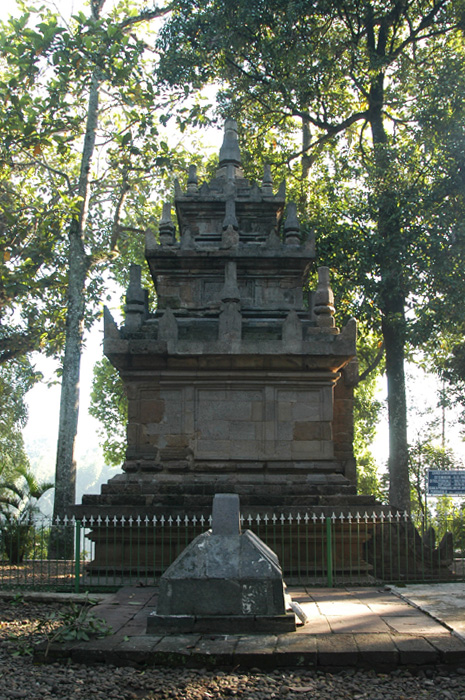|
Sulaeman Sastrawinata
Raden Adipati Aria Sulaeman Sastrawinata (27 February 1869 – 16 June 1951) was a Sundanese aristocrat and the regent of Ciamis under the Dutch East Indies from 1914 to 1935. Early life Sastrawinata was born in Purwakarta, West Java. He had been the chief prosecutor () in Serang. Regent of Ciamis Sastrawinata was appointed regent () in 1914, replacing the retiring Raden Adipati Aria Kusumabrata of Galuh. In 1916, he changed the name of Galuh to Ciamis, a move that brought disapproval among many residents. Death Sastrawinata died on 16 June 1951. Marriages and children Sastrawinata's first marriage was to Mojanegara, whom he married in 1896. She died of dysentery and did not bear him any children, but they adopted a niece and nephew from Purwakarta. When she was seeking treatment from Dutch doctors in Garut, she became fond of a local girls' school teacher named Suhaemi, who was 15 years old at the time. Prior to her death, Mojanegara asked her husband to marry Suhaem ... [...More Info...] [...Related Items...] OR: [Wikipedia] [Google] [Baidu] |
Ciamis
Ciamis ( su, ᮎᮤᮃᮙᮤᮞ᮪) is a town and district which serves as the regency seat of Ciamis Regency in West Java, Indonesia. Government GOVERNMENT Since regional autonomy was implemented in 2001, Ciamis Regency has experienced regional expansion into Ciamis Regency with 30 districts and Banjar City 4 districts. Along with the increase in population in Ciamis Regency and to reduce the span of government control in 2006, Ciamis Regency experienced the expansion of 6 districts, so rising from 30 districts to 36 districts. Likewise for the number of villages, during the period 2007 – 2009, the number of villages increased by 3 villages. Likewise, for the same period, the number of Neighborhood Associations (RW) and Neighborhood Units (RT) experienced an increase of 27 Rukun Warga (RW) and 92 Rukun Tetangga (RT). The number of civil servants in Ciamis increased from 18,404 people in 2008 to 18,966 people in 2009. Based on the composition of employees by gender, during 2007 - ... [...More Info...] [...Related Items...] OR: [Wikipedia] [Google] [Baidu] |
19th-century Dutch East Indies People
The 19th (nineteenth) century began on 1 January 1801 ( MDCCCI), and ended on 31 December 1900 ( MCM). The 19th century was the ninth century of the 2nd millennium. The 19th century was characterized by vast social upheaval. Slavery was abolished in much of Europe and the Americas. The First Industrial Revolution, though it began in the late 18th century, expanding beyond its British homeland for the first time during this century, particularly remaking the economies and societies of the Low Countries, the Rhineland, Northern Italy, and the Northeastern United States. A few decades later, the Second Industrial Revolution led to ever more massive urbanization and much higher levels of productivity, profit, and prosperity, a pattern that continued into the 20th century. The Islamic gunpowder empires fell into decline and European imperialism brought much of South Asia, Southeast Asia, and almost all of Africa under colonial rule. It was also marked by the collapse of the lar ... [...More Info...] [...Related Items...] OR: [Wikipedia] [Google] [Baidu] |
1951 Deaths
Events January * January 4 – Korean War: Third Battle of Seoul – Chinese and North Korean forces capture Seoul for the second time (having lost the Second Battle of Seoul in September 1950). * January 9 – The Government of the United Kingdom announces abandonment of the Tanganyika groundnut scheme for the cultivation of peanuts in the Tanganyika Territory, with the writing off of £36.5M debt. * January 15 – In a court in West Germany, Ilse Koch, The "Witch of Buchenwald", wife of the commandant of the Buchenwald concentration camp, is sentenced to life imprisonment. * January 20 – Winter of Terror: Avalanches in the Alps kill 240 and bury 45,000 for a time, in Switzerland, Austria and Italy. * January 21 – Mount Lamington in Papua New Guinea erupts catastrophically, killing nearly 3,000 people and causing great devastation in Oro Province. * January 25 – Dutch author Anne de Vries releases the first volume of his children's novel '' Journey Through ... [...More Info...] [...Related Items...] OR: [Wikipedia] [Google] [Baidu] |
1869 Births
Events January–March * January 3 – Abdur Rahman Khan is defeated at Tinah Khan, and exiled from Afghanistan. * January 5 – Scotland's oldest professional football team, Kilmarnock F.C., is founded. * January 20 – Elizabeth Cady Stanton is the first woman to testify before the United States Congress. * January 21 – The P.E.O. Sisterhood, a philanthropic educational organization for women, is founded at Iowa Wesleyan College in Mount Pleasant, Iowa. * January 27 – The Republic of Ezo is proclaimed on the northern Japanese island of Ezo (which will be renamed Hokkaidō on September 20) by remaining adherents to the Tokugawa shogunate. * February 5 – Prospectors in Moliagul, Victoria, Australia, discover the largest alluvial gold nugget ever found, known as the " Welcome Stranger". * February 20 – Ranavalona II, the Merina Queen of Madagascar, is baptized. * February 25 – The Iron and Steel Institute is form ... [...More Info...] [...Related Items...] OR: [Wikipedia] [Google] [Baidu] |
Supreme Court Of Indonesia
The Supreme Court of the Republic of Indonesia ( id, Mahkamah Agung Republik Indonesia) is the independent judicial arm of the state. It maintains a system of courts and sits above the other courts and is the final court of appeal. It can also re-examine cases if new evidence emerges. Jurisdiction The Supreme Court is independent as of the third amendment to the Constitution of Indonesia. The Supreme Court has oversight over the high courts (''Pengadilan Tinggi'') and district courts (''Pengadilan Negeri''). There are about 68 high courts: 31 General Courts, 29 Religious Courts, 4 Administrative Courts and 4 Military Courts. There are around 250 district courts with additional district courts being created from time to time.In late 2011, the former chief justice of the Supreme Court, Harifin A. Tumpa, said that the Indonesian government could only aim to establish district courts in 400 of the nation's 530 provinces, regencies (''kabupaten'') and municipalities (''kotamadya'') ... [...More Info...] [...Related Items...] OR: [Wikipedia] [Google] [Baidu] |
Sumedang
Sumedang (former spelling: Soemedang) is a town in Western Java, Indonesia, approximately 46 km northeast of Bandung. It is the capital of Sumedang Regency. The town is just south of the volcanic Mount Tampomas, which is 1,684 m (5,525 ft) high and is usually climbed from Cimalaka District, 7 km from Sumedang. Sumedang's museum, Prabu Geusan Ulun, houses a collection of traditional Sundanese weaponry, as well as some crown jewels and other finery. It is on Geusan Ulun Road. The town is famous for '' Sumedang tofu'', a local variety of deep fried tofu which was first made by a Chinese immigrant, Ong Kino. In the district surrounding the town lies Cadas Pangeran, a section of the trans-Java postal road constructed on the order of Dutch governor named Willem Daendels during the first quarter of the 19th century. The section is famous due to difficulty during the construction, which required blasting of a mountainside. Hence "cadas" which means mountain ro ... [...More Info...] [...Related Items...] OR: [Wikipedia] [Google] [Baidu] |
Garut
Garut is a district and town in West Java of Indonesia, and the former capital of Garut Regency. It is located about 75 km to the southeast of the major city of Bandung. History The modern history of Garut started on March 2, 1811 when Balubur Limbangan Regency was dissolved by Governor General Herman Willem Daendels, because the area's production of coffee had decreased and the Regent, Tumenggung Wangsakusumah II had refused a command to plant indigo. Balubur Limbangan Regency then comprised 6 districts: Balubur, Malangbong, Wanaraja, Wanakerta, Cibeureum and Papandak. The Limbangan Regency, which has now become the Garut Regency, was founded by Lieutenant-Governor Stamford Raffles on 16 February 1813. RAA. Adiwijaya, who governed from the 1813 until 1821, was the first Regent of the Garut Regency. He was well known as Dalem Cipeujueh. The town of Suci was originally the capital of the new Limbangan Regency. However it was thought that Suci did not meet the requireme ... [...More Info...] [...Related Items...] OR: [Wikipedia] [Google] [Baidu] |
Dysentery
Dysentery (UK pronunciation: , US: ), historically known as the bloody flux, is a type of gastroenteritis that results in bloody diarrhea. Other symptoms may include fever, abdominal pain, and a feeling of incomplete defecation. Complications may include dehydration. The cause of dysentery is usually the bacteria from genus '' Shigella'', in which case it is known as shigellosis, or the amoeba '' Entamoeba histolytica''; then it is called amoebiasis. Other causes may include certain chemicals, other bacteria, other protozoa, or parasitic worms. It may spread between people. Risk factors include contamination of food and water with feces due to poor sanitation. The underlying mechanism involves inflammation of the intestine, especially of the colon. Efforts to prevent dysentery include hand washing and food safety measures while traveling in areas of high risk. While the condition generally resolves on its own within a week, drinking sufficient fluids such as oral ... [...More Info...] [...Related Items...] OR: [Wikipedia] [Google] [Baidu] |
Bupati
A regency ( id, kabupaten), sometimes incorrectly referred to as a district, is an administrative division of Indonesia, directly under a province and on the same level with city (''kota''). Regencies is divided into districts (''Kecamatan'', ''Distrik'' in Papua region, or ''Kapanewon'' in the Special Region of Yogyakarta). The English name "regency" comes from the Dutch colonial period, when regencies were ruled by ''bupati'' (or regents) and were known as ''regentschap'' in Dutch (''kabupaten'' in Javanese and subsequently Indonesian). ''Bupati'' had been regional lords under the precolonial monarchies of Java. When the Dutch abolished or curtailed those monarchies, the bupati were left as the most senior indigenous authority. They were not, strictly speaking, "native rulers" because the Dutch claimed full sovereignty over their territory, but in practice, they had many of the attributes of petty kings, including elaborate regalia and palaces and a high degree of impunity. Et ... [...More Info...] [...Related Items...] OR: [Wikipedia] [Google] [Baidu] |
Wilhelmina Of The Netherlands
Wilhelmina (; Wilhelmina Helena Pauline Maria; 31 August 1880 – 28 November 1962) was Queen of the Netherlands from 1890 until her abdication in 1948. She reigned for nearly 58 years, longer than any other Dutch monarch. Her reign saw World War I, the Dutch economic crisis of 1933 and World War II. The only child of King William III of the Netherlands and Emma of Waldeck and Pyrmont, Wilhelmina ascended to the throne at the age of 10 after her father's death in 1890, under her mother's regency. After taking charge of government, Wilhelmina became generally popular for maintaining Dutch neutrality during the First World War and solving many of her country's industrial problems. By that time, her business ventures had made her the world's first female billionaire in dollars. She went on to ensure that her family was one of seven European royal houses remaining in existence. Following the German invasion of the Netherlands in 1940, Wilhelmina fled to Britain and took charge o ... [...More Info...] [...Related Items...] OR: [Wikipedia] [Google] [Baidu] |



%2C_p168.jpg)



